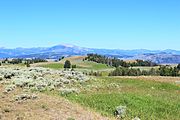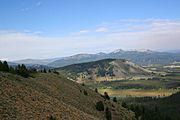Plateaus of Yellowstone National Park facts for kids
Yellowstone National Park is famous for its amazing natural features, including nine special flat-topped areas called plateaus. These plateaus are like huge, elevated flat lands. They are part of an even bigger area known as the Yellowstone Plateau. You can find them mostly in the southern and western parts of the park, near the Gallatin and Absaroka mountains. Four of these plateaus were formed by a type of lava called rhyolite that flowed between 110,000 and 70,000 years ago.
Contents
Exploring Yellowstone's Plateaus
Let's take a closer look at each of these unique plateaus in Yellowstone National Park!
Blacktail Deer Plateau
44°55′28″N 110°34′05″W / 44.92444°N 110.56806°W
- Location and Size: This plateau is about 7,113 feet (2,168 m) high.
- Easy to Visit: It's one of the easiest plateaus to reach in the park. The Grand Loop Road, a main road in Yellowstone, crosses right through it.
- How it Got its Name: The Blacktail Deer Plateau is named after Blacktail Deer Creek, which flows from it. Early explorers and prospectors named it before the park was even created in 1872. They likely saw many Blacktail deer in the area.
Buffalo Plateau
44°59′47″N 110°14′46″W / 44.99639°N 110.24611°W
- Location and Size: This plateau is about 8,251 feet (2,515 m) high. It sits right on the border between Montana and Wyoming. You'll find it north of the Lamar Valley and west of Slough Creek.
- How it Got its Name: In 1870, before Yellowstone became a park, prospectors named this plateau. They called it Buffalo Plateau because of the many herds of buffalo that lived there.
- Trails: You can explore parts of this plateau using the Buffalo Plateau trail and the Buffalo Fork Trail.
Central Plateau
44°35′49″N 110°37′44″W / 44.59694°N 110.62889°W
- Location and Size: The Central Plateau is about 8,399 feet (2,560 m) high.
- Natural Divide: It acts like a natural divider. On its east side, water flows into the Hayden Valley and the Yellowstone River. On its west side, water flows towards the Lower Geyser Basin and the Madison River.
Madison Plateau
44°21′02″N 110°58′18″W / 44.35056°N 110.97167°W
- Location and Size: This is the largest of the named plateaus, standing at about 8,435 feet (2,571 m) high. It's located south of the Madison River and west of the Upper and Lower Geyser Basins. It stretches all the way to the park's western border.
- Hard to Reach: The Madison Plateau is very remote and difficult to access. Only one trail, the Summit Lake Trail, crosses it from east to west. The Fairy Creek Trail also touches its eastern edge, leading to Fairy Falls.
Mirror Plateau
44°43′55″N 110°07′32″W / 44.73194°N 110.12556°W
- Location and Size: The Mirror Plateau is about 8,714 feet (2,656 m) high. It's a remote area west of the upper Lamar River. Water from here flows into Pelican Creek, which then goes into Yellowstone Lake.
- How it Got its Name: This plateau is named after Mirror Lake. The lake was first called Divide Lake because it separates the water flowing into the Lamar and Pelican Creeks. In 1878, Ferdinand V. Hayden, a famous geologist, renamed it Mirror Lake because its calm waters perfectly reflect the surrounding landscape.
Pitchstone Plateau
44°15′11″N 110°46′24″W / 44.25306°N 110.77333°W
- Location and Size: The Pitchstone Plateau is about 8,881 feet (2,707 m) high. It's found in the southwest corner of the park, in the areas where the Bechler and Fall River flow.
- How it Got its Name: This plateau gets its name from pitchstone, a type of volcanic glass. The plateau itself was formed by rhyolite lava flows about 70,000 years ago.
Solfatara Plateau
44°43′53″N 110°32′45″W / 44.73139°N 110.54583°W
- Location and Size: Solfatara is a smaller plateau, about 8,166 feet (2,489 m) high. It's located near the start of the Gibbon River, west of Canyon and south of Grebe Lake.
- How it Got its Name: In 1883, geologist Walter Weed named it Solfatara. A solfatara is a type of volcanic vent that releases steam and gases like hydrogen sulfide. He likely found such a vent here.
- Trails: The Norris-Canyon road runs along its southern edge, and the Wolf Lake-Cascade Lake trails are to its north. The Grebe Lake trail crosses the middle of the plateau.
Trident Plateau
44°11′36″N 110°00′40″W / 44.19333°N 110.01111°W
- Location and Size: The Trident Plateau is the highest of these plateaus, reaching about 10,649 feet (3,246 m). It's a small, remote plateau in the southeast corner of the park. It's near the start of the Yellowstone River and extends east into the Teton National Forest in Wyoming.
- How it Got its Name: Geologist Arnold Hague named it in 1885. He thought it looked like a three-pronged Trident, a type of spear.
Two Ocean Plateau
44°10′33″N 110°12′59″W / 44.17583°N 110.21639°W
- Location and Size: This plateau is about 9,478 feet (2,889 m) high.
- Unique Feature: The Two Ocean Plateau is named for a very special reason: the Continental Divide crosses right over it! This means that rain or snow that falls on this plateau can end up in two different oceans.
- Water's Journey: One creek on the plateau flows south and then splits at a place called the Parting of the Waters. One part of the creek eventually reaches the Pacific Ocean, while the other flows to the Gulf of Mexico.
Gallery





